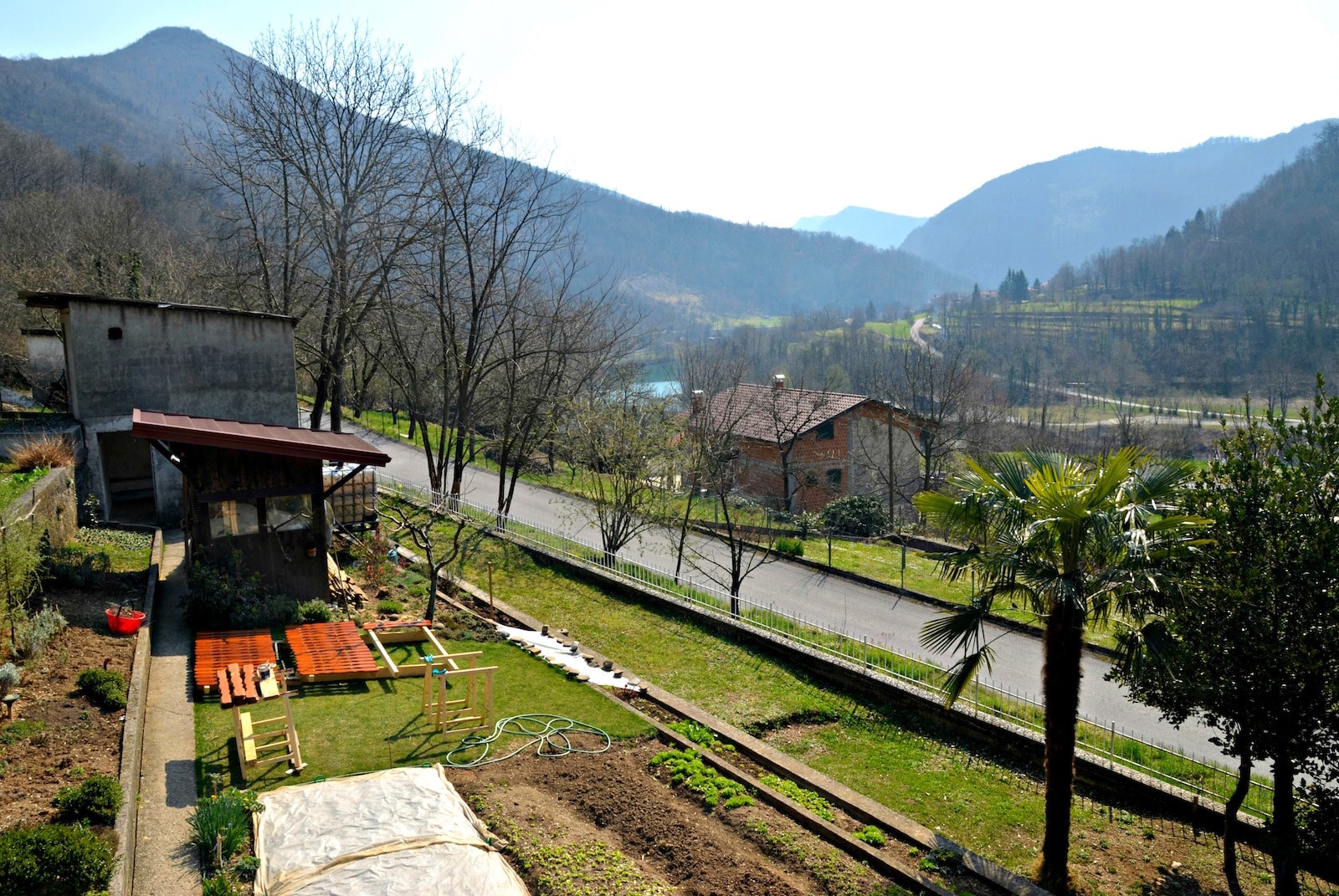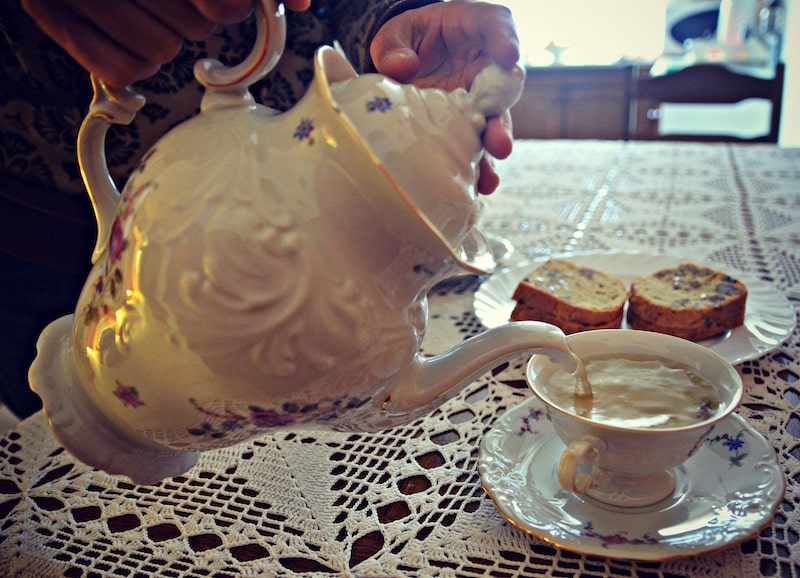Slow Travel: A Slovenian Countryside Homestay With A Curative Twist
By Jessie Festa. This post originally appeared on Epicure & Culture.
“When it comes to herbs it’s best not to pick what’s in dirt or has no dirt or scratches as it affects the flavor and color later.”
I’m currently standing in a fragrant forest in Plave — a small village in Slovenia — lush with wild garlic, primrose and chives.
Well, not really standing. Picking.
With bent knees and basket in hand, I’m following trained local herb picker, Vesna, around the woods as she teaches me the correct way to pick wild garlic, or ransoms, plucking only the best leaves — and doing so one by one, to ensure not to accidentally pick poisonous plants.
Oh, and of course inhaling each one.
I’m also staying in her family home. The very one she grew up in with her brother and parents, an adorable vineyard cottage.
A True Homestay In Slovenia
Vesna’s inspiration for the Herbal House was her desite to always have a hostel and meet people from around the world, showing them the beauty of Slovenia.
She explains, “My parents adored hosting Couchsurfers when I was still staying with them. I made a compromise. Instead of building a new house somewhere else, I choose to renovate two former children’s rooms — which used to belong to my brother and I — into rooms where guests can sleep on herbs that relax the body and soul. My goal is that guests try and realize how effective the herbs are for our lives, how important is to breath herb aromatherapy, how to relax on herbs and how to feel the nature, the pastures of dried herbs in the room.”
While most tourists decide to stay in Ljubljana, Lake Bled and Triglav National Park, I’ve opted to travel about 90 minutes outside the capital to experience a Slovenian countryside homestay at Herbal House in the beautiful Soča Valley, aptly named for the extensive use of fresh locally picked herbs in their cooking, cleaning, healing and rituals. For example, I’m welcomed by Vesna’s mother with a homemade fennel, citronella and yarrow tea served with a homemade nut and dried fruit sweet bread, a traditional snack for Slovenians to eat the night before Three Kings Day. My guest room features a translucent jar of dried yarrow, wild thyme, violet and primrose — which Vesna chose for their mix of eye-catching colors — as well as pillows packed with linden and wild hops for relaxation and a fern-embedded mattress to help combat rheumatoid issues.
Outside, 20 different herbs either picked from nature or purchased at organic farms have been replanted in an herb garden, which Vesna takes me on a tour of, pointing out peppermint, which kills bacteria and is used in her homemade toothpaste; sage, great for tooth and gum issues and sore throat; and daisies, which aid in digestion, to name a few.
Herbal House is a true family-run homestay experience, from a hearty barley soup lunch made by Vesna’s mother, Karmen, to wooden furniture in the home made by Vesna’s father, Ivan. When I start sneezing, Ivan pours us each a small glass of homemade pomegranate liqueur made with schnapps, explaining — with Vesna as the translator — that the drink warms the body and keeps illness at bay. Karmen teaches me how to say a few important phrases in Slovenia, like “enjoy your meal” (dober tek), “coffee” (kava) and “thank you” (hvala). The entire family welcomes me and makes me feel like I’m at a home away from home, so much so that I almost forget the language difference, kindness and the desire to better understand one another breaking down these barriers.
And of course, there’s Vesna, who speaks fluent English and loves creating a truly memorable experience for guests.
She explains, “I never rent out both herbal rooms at the same time. I want to be able to really spend time with every person that visits, really get to know each other and introduce them to what country life in Slovenia is like. The things that are shared during the stay last forever.”
Plave’s Rich History
Plave seems the perfect place to do it, a quiet village with a population of 233 and a rich history. From my room’s balcony I can see the Kuk, Sabotin and Korada Mountains, as well as the Soča River, touted as one of Europe’s most beautiful due to its vibrant emerald color. Interestingly, this river once split Plave into two nationalities, Italy on the right and Austro-Hungarian on the left, which had a huge impact on the culture as it is today.
Says Vesna, “According to the stories of old locals living in Plave, the villagers who were living on the right side of the Soča River were sent to Italy when Isonzo front started. They got in contact with tomatoes, basil, pasta and pizza for the first time; while the villagers from Plave who were living on the left side of the Soča river, were sent to Jesenice, Ljubljana and refugee camps in Austria. After WWII, Plave was under Allied Military Government and the villagers came in contact with American culture, like chewing gums, tights, sugar, candies, canned food, volleyball and music.”
A Lesson In Natural Living
After an enchanting herb picking walk through the forest where I gain a deeper understanding of nature’s bounty, we head back to the house to put our ingredients to good use. First, through the palate, as we make a delicious frtalja, made with eggs (from a lady with hens down the street), flour, milk, salt, cheese, sparkling water for softness and the wild garlic from today. “Deeply satisfied” is one way to describe my sentiments as I bite into our creation, gooey cheese dripping out of fried egg and ransoms adding a mild spice.
Second, through the body. Vesna is a master at transforming curative herbs into healing herbal products, including soaps and body balms. Today, she shows me how to make my own calendula body balm, a universal balm helpful for everything from dry skin to wounds to complexion.
Vesna has gotten the process started by drying the calendula petals and infusing them into olive oil for the past five to six weeks. It’s visible the orange of the herb has seeped into the oil, meaning it’s ready to be poured over a cheesecloth and strainer to remove the solids and keep the oil. Small pieces of beeswax are added to the oil and the mixture is put into a breaker, which is placed in a pot of boiling water to cook. Once it’s ready, lavender essential oil is added as a preservative, and the concoction is left to cool and dry for about 10 minutes.
Vesna informs me the best way to apply the balm is right after a shower when there are still droplets of water on the body, as this helps eliminate shine. She hands me the jar of balm we’ve just made together, and I can’t wait to bring it home to try for myself. If I can even wait that long.
Both the food and body balm seem uber simple to make — and they probably would be if I had Vesna to prepare all the ingredients for me; however, her formal training in herb picking is something I lack, not to mention Brooklyn isn’t exactly home to the lushest of forests. The way she air dries the herbs in racks made by her father, carefully covering them with cloth so the sun doesn’t damage them; the way she delicately ties each hand-made herbal soap with small brown strings; the way she patiently waits for her infusions to complete, or for her homemade Jägermeister to ferment. These are skills I do not posses.
Although I guess it doesn’t matter, because there’s a place where I can experience these natural bounties without having a green thumb myself, a place I can call home in Slovenia.
A Sharing Of Cultures
But it isn’t just the herbal experiences that make the stay. It’s the sharing of cultures. Vesna and I exchange stories about dating, American vs Slovenian politics and lifestyles, traveling abroad and personal anecdotes from our lives. I learn interesting traditions, like giving ruby red Teran wine mixed with yolk and sugar to new mothers to improve blood health and strength. There are also interesting facts and anecdotes, like how Slovenia is known for its honey culture, home to the protected Carniolan bee, or that when Slovenia was part of communist Yugoslavia families would cross the border to Italy to bring back goods like chewing gum, jeans, cigarettes, whiskey and chocolate.
By the time 7:30pm rolls around and the evening’s meal is being set out, I haven’t even noticed the sun has set we’re so deep in conversation.
Dinner tonight is a sumptuous feast of white polenta, goulash and fresh salad we picked during the day from the garden. It’s topped with a wild garlic spread mixed with olive oil. We all share a bottle of Slovenian merlot, toasting to a wonderful day. We have no place to be but here, to relish in the deliciousness of the day, to enjoy the quiet of the village, to savor life away from screens.
Speaking of screens, Vesna lives her life without a smartphone. The key phrase here being “lives her life,” not possessed by Instagram or incessant emails. There is a time for a work and a time for pleasure. Lucky for her, she love what she does — the herb picking, the cooking, the creating, the exchange of cultures. Lucky for travelers like us, she extends an open invitation to all who want to experience it with her.
Herbal House is slow travel at its finest.
Essential Information:
Herbal House, [email protected], +386 (0) 41 432 488. Herbal House is part of Slocally, Vesna’s company offering local experiences, activities, guides and accommodation. Even if you can’t spend a night in the Herbal House it’s recommended to check out the many local day offerings or hire a guide for 25 Euros ($27 USD) per hour.
Getting There: Plave is located about 90 minutes by car from Ljubliana. You can also use car sharing, a popular mode of transport in Slovenia. Using the train system, you can head from Ljubliana to Jesenice and switch to the train to Plave, with the journey taking about three hours in total. From Lake Bled, there is a one-hour train that goes straight to Plave.
Rates: 27 Euros (~29 USD) per person per night for the double room, and 30 Euros (~$32 USD) per night for the single room; activities start at 25 Euros (~$27 USD); guests are welcome to join the family for meals, and while there is no charge tips are appreciated.
Pack: Linens, towels and homemade herbal soaps are provided; however, shampoo, conditioner and other toiletries should be brought by you.
Bonus Slovenia Travel Tips
Visiting Lake Bled In Slovenia
The Solo Traveler’s Guide To Ljubljana, Slovenia











Hi, I’m Jessie on a journey!
I'm a conscious solo traveler on a mission to take you beyond the guidebook to inspire you to live your best life through travel. Come join me!
Want to live your best life through travel?
Subscribe for FREE access to my library of fun blogging worksheets and learn how to get paid to travel more!
Turn Your Travel Blog Into A Profitable Business
Subscribe to my email list to snag instant access to my library of workbooks, checklists, tutorials and other resources to help you earn more money -- and have more fun -- blogging. Oh, and it's totally FREE! :) // Privacy Policy.